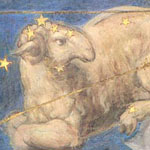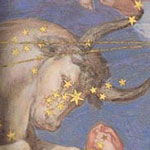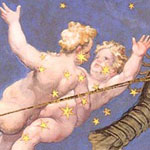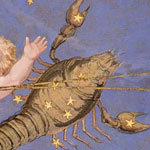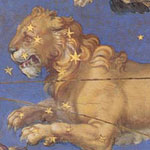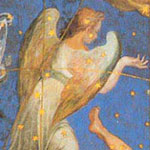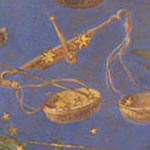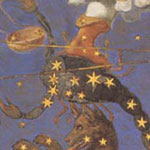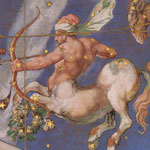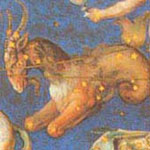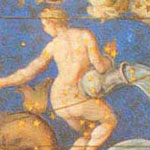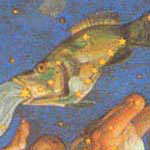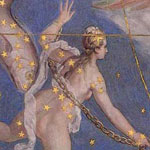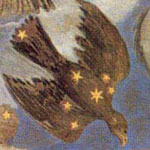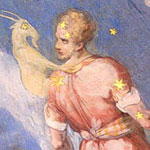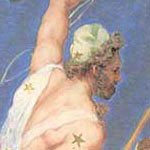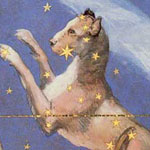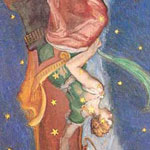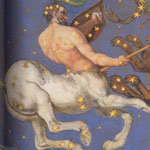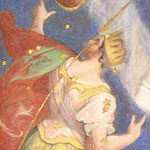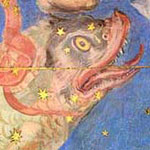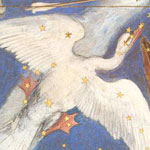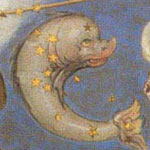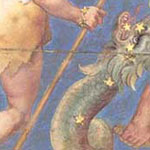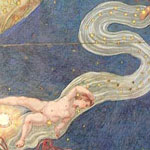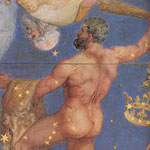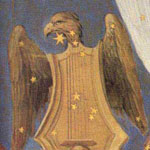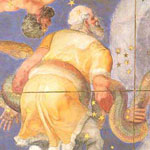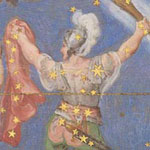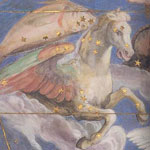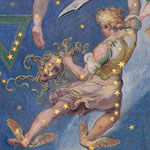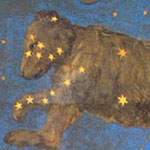STAR MYTHS
The Greek word for constellations was katasterismoi. Of these, the twelve signs whose paths intersect with the dawn rising of the sun were known as zodiakos (the zodiac) or zodiakos kyrklos (circle of small animals). The constellations, as described in Greek mythology, were mostly god-favoured heroes and beasts who received a place amongst the stars as a memorial of their deeds. They were regarded as semi-divine spirits--living, conscious entities which strode across the heavens.
The main sources of Greek star myths were the lost astronomical poems of Hesiod and Pherecydes and later works by Pseudo-Eratosthenes, Aratus and Hyginus.
I. THE ZODIAC
II. OTHER CONSTELLATIONS
REVOLUTIONS OF THE CONSTELLATIONS
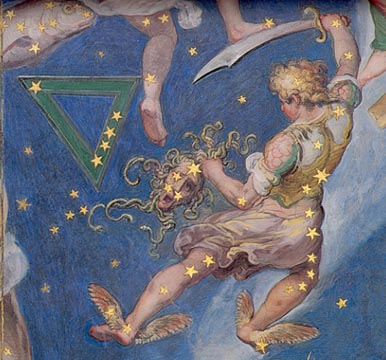
For those unfamiliar with the basic visible mechanics of constellar movement, what follows is a brief outline, including Greek beliefs regarding the behaviour of the stars.
The constellations revolve round a central point in the northern sky known as the pole star, or heavenly axis (Greek polos). Because of its far northern location, most of the stars are seen to rise in the east and set in the west. Only those few closest to the pole--namely, Ursa Major and Minor (the Bears), and Draco (the Dragon)--appear to travel at night in an eternal circle around the pole.
Not all of the constellations are visible in the night sky throughout the year. The first appearance of a constellation in the sky, occurs on the western horizon just prior to dawn (its so-called heliacal rising). As the months progress it is seen to rise earlier and earlier in the night, and gradually assumes a higher position in the heavens prior to dawn, until one evening, it has reached the western horizon, before dissappearing completely from view (which is known as the constellation's astronomical setting).
The most important of the heliacal risings were those of the twelve constellations of the zodiac. They were said to rule the heavens for the period in which their position on the eastern horizon prior to dawn was replaced by the rising sun. So, for example, Gemini first rises above the eastern horizon in late May, appearing in the sky just prior to dawn, where its position is immediately replaced by the rising sun. As the constellation gradually rises earlier and earlier in the night, its place on the solar horizon at dawn is eventually replaced by the next constellation of the zodiac, namely Cancer, in mid June.
The Greeks imagined the heavens as a great, solid dome, which, some say, was forged of bronze, and upon which the heavenly constellations were fixed. The Titan Atlas, who stood either beneath the axis of heaven in the far north (in the land of the Hyperboreans), or at heaven's western rim in by the Atlas mountains in North Africa, was said to spin the dome around upon his shoulders, causing the stars to rise and set.
Part of the heavenly dome always lay beneath the horizon. Here the constellations were apparently believed to dwell deep beneath the earth in the misty pit of Tartaros, or else within the lands of the dead. When they rose up into the heavens, the constellations were first bathed in the purifying waters of the great earth-encircling river Okeano. Various myths describe the birth and death of the semi-immortal constellations: such as the Gemini twins, or Dioskouroi, who were said to divide their time equally between Heaven and Haides. Orion was also described by Homer both striding across the heavens and hunting wild beasts in the underworld.
IMAGES OF THE CONSTELLATIONS
There are very few surviving depictions of the constellations in classical art: at most, a few Roman mosaics, and a partial depiction on the famous Farnese statue of the Titan Atlas.
The images on this page are from a Renaissance-era ceiling fresco (circa 1573) decorating the Villa Farnese in Caprarola, Italy.
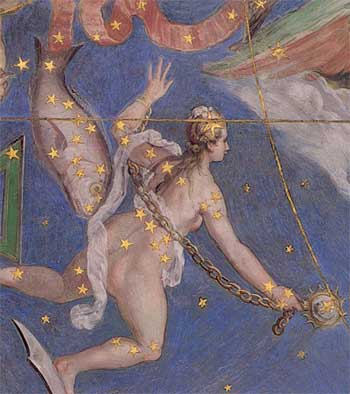
KEY TO INDIVIDUAL ENTRIES
HEADING The common English name for the constellation.
Latin : the Roman name of the constellation (usually the same as the one used in
English today)
Greek : The Greek name of the constellation.
Akkadian & Sumerian : The old Eastern name for the constellation, predating the
Greek. *
NAME A character associated with the constellation in surviving compilations of star myths.
* The form and arrangment of the heavenly constellations was adopted by the Greeks from the sea-trading Phoenicians of the East, who in turn had received them from the Assyrians, and they from their forefathers the ancient Sumerians. As a result the Greeks had a number of alternate myths describing each of the star groups, as the foreign traditions were translated in different ways by the various regions and poetical traditions of ancient Greece.
SUMERIAN & AKKADIAN CONSTELLATIONS
For a list of Sumerian and Akkadian constellation names see : The Star Catalogue (external link).
CONSTELLATIONS & THE ADVENTURES OF HERACLES
Heracles, "glory of the air," had his labours represented amongst the stars of heaven. The formula was evidently adopted from eastern sources, in particular the star myths of the so-called "Phoenician Heracles," the hero-god of Lebanon, Melqart. A number of his labours, although missing from the late Greek constellar arrangements, are perhaps recognisable in their older Eastern forms.
The adventures of Heracles can be paired with the following constellations : (1) the Nemean Lion, constellation Leo; (2) the Hydra and Crab, constellations Hydra and Cancer; (3) the Stymphalian Birds, constellations Lyra and Cygnus; (4) the Cretan Bull, constellation Taurus; (5) the Hesperian Dragon, constellation Serpens; (6) Herakles wrestling Apollon, constellation Gemini; (7) Prometheus and the Caucasian Eagle, constellations Hercules and Aquilla; (8) the centaur Cheiron or Pholus, constellation Saggitarius or Centaurus; et. al.
ANDROMEDA
Latin : Andromeda
Greek : Andromedê
Sumerian : LU.LIM (the Stag)
Akkadian : Lulimu (the Stag)
ANDROMEDA A Princess of Ethiopia, daughter of Cepheus and Cassiopea. Her mother offended the gods by boasting that the girl was more beautiful than the Nereids. Poseidon in wrath sent a sea-monster to devour the girl. When she was chained to the rocks, the hero Perseus spied her, slew the beast, and carried her off as his wife. The gods as a memorial, set the whole family amongst the stars as constellations. (Hyginus 2.11, Aratus 197.)
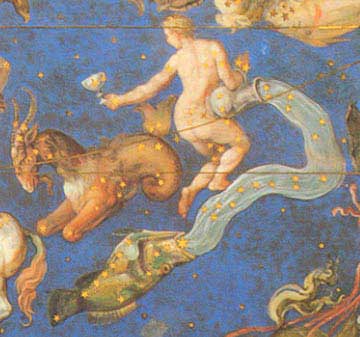
AQUARIUS
Latin : Aquarius (Water Bearer)
Greek : Hydrokhoos (Water-Bearer)
Sumerian : GU.LA (the Great)
GANYMEDES A handsome Trojan prince. He was seized and carried off to heaven by an eagle sent down by Zeus, to become the cup-bearer of the gods. The eagle and boy were subsequently placed amongst the stars as the constellations Aquila and Aquarius. (Hyginus 2.16 & 2.29.)
DEUCALION An early Greek king who managed to survive the great Deluge that was sent by Zeus to destroy mankind. Because so much rain fell during his reign he was represented amongst the stars as the Water-Pourer. (Hyginus 2.29 on Hegesianax.)
CECROPS An early king of Athens who was the first to pour libations in honour of the gods. In memory of this he was placed in the heavens as the water-pourer Aquarius. (Hyginus 2.29 on Eubulus.)
AQUILA
Latin : Aquila (the Eagle)
Greek : Aiêtos (the Eagle)
Akkadian : Erû (the Eagle)
Sumerian : Á.MUSHEN (the Eagle)
EAGLE OF APHRODITE When Zeus wished to seduce the goddess Nemesis, he transformed himself into a swan, and bade Aphrodite pursue him into her lap in the guise of an eagle. In this way he accomplished his seduction and in memorial placed an eagle and swan amongst the stars. (Hyginus 2.8.)
EAGLE OF PROMETHEUS An eagle which was set by Zeus feed on the liver of the chained Titan Prometheus. When Heracles freed him from his chains, he slew the eagle with an arrow, and Zeus placed the pair amongst the stars as Aquila (eagle) and Sagitta (arrow). (Hyginus 2.15.)
EAGLE OF ZEUS 1 The eagle which Zeus sent to snatch the handsome Trojan youth Ganymedes up to heaven. The boy and eagle were placed amongst the stars as the adjacent constellations Aquarius and Aquila. (Hyginus 2.16.)
EAGLE OF ZEUS 2 An eagle which appeared to Zeus as a sign of good omen when he was sacrificing on an altar prior to the commencement of his war against the Titans. To commemorate the event he placed the eagle and altar amongst the stars as the constellations Aquila and Ara. (Hyginus 2.16.)
EAGLE OF ZEUS 3 When Hermes was wooing the goddess Aphrodite she spurned his advances. Zeus, pitying his son, sent an eagle which snatched away her sandal and delivered it the god, which he used to barter for her favours. The eagle was rewarded with a place amonst the stars. (Hyginus 2.16.)
MEROPES A King of Cos whose wife was killed by Artemis for spurning her worship. When he was about to commit suicide in his grief, Hera transformed Meropes into an eagle and placed him amongst the stars in the form of Aquila. (Hyginus 2.16 on Aglaosthenes.)
ARA
Latin : Ara (the Altar)
Greek : Thytêrios (the Altar)
ALTAR OF ZEUS When Zeus had gathered allies for the Titan War, they made sacrifices on an atlar constructed by the Cyclopes to pledge their alliegance. In memorial the god placed it amongst the stars as the constellation Ara. The rising of its stars heralded the storms of late autumn. (Hyginus 2.39.)
ALTAR OF PHOLUS The kindly centaur Pholus was set amongst the stars by Zeus for his skill in augury. He was depicted pouring libations at the atlar in the form of the three constellations Ara (the Altar), Crater (the Cup), and Centaurus (the Centaur). (Hyginus 2.38.)
ARGO
Latin : Argo
Greek : Argô (the Silver (Ship)
ARGO The ship of the hero Argonauts which was constructed by Argus and Athena, with a talking beam placed on its prow. After their voyage in search of the Golden Fleece, the ship was placed amongst the stars in memorial as the constellation Argo. Only half of the ship can be seen in the stars, the forepart from stern to mast. (Hyginus 2.37.)
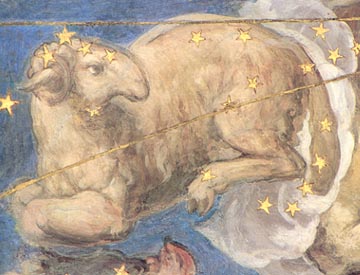
ARIES
Latin : Aries (the Ram)
Greek : Krios (the Ram)
Akkadian : Argu (the Hired Man)
Sumerian : LÚ.HUN.GÁ (the Hired Man)
CHRYSOMALLUS A flying, golden-fleeced ram. It was sent by the cloud nymph Nephele to rescue her children, Phrixus and Helle, who were about to be sacrificed to the gods. The ram carried them across the seas, but Helle lost her grip and fell. Upon reaching Colchis the ram shed its golden fleece for Phrixus who hung it in a sacred grove, and flew up to the heavens to take a place amongst the stars as the dimly shining constellation Aries. (Hyginus 2.20 on Hesiod & Pherecydes & Eratosthenes.)
RAM OF AMMON 1 When the god Dionysus led his armies into Africa and they were suffering in the desert, a ram appeared and guided him to the springs of Ammon. As a memorial the god set the creature amongst the stars as the constellation Aries, first of the twelve signs of the zodiac. {Hyginus 2.20 on Hermippus.)
RAM OF AMMON 2 An Egyptian (god) named Hammon was the first to herd flocks of sheep. To honour his gift to mankind, a ram was set amongst the stars. (Hyginus 2.20 on Leon.)
AURIGA
Latin : Auriga (the Charioteer)
Greek : Hêniokhos (the Charioteer)
Akkadian : Gamlu (the Crook)
Sumerian : GÀM (the Crook)
Latin : Capra (the Goat)
Greek : Aix Olenios (the Goat on the Left)
ERICHTHONIUS An early King of Athens who invented the four-horse chariot. As a reward for his gift to mankind Athena placed him amongst the stars as the constellation Auriga. (Hyginus 2.13 on Eratosthenes.)
MYRTILUS The charioteer of King Oinomaos of Pisa, and a son of the god Hermes. When he was murdered by Pelops, his father set him in the heavens as the constellation Auriga. (Hyginus 2.13.)
ORSILOCHUS An Argive man who in local legend was the inventor of the chariot. The gods placed him amongst the stars as Auriga in memorial. (Hyginus 2.13.)
AEX OF HELIUS A goatish daughter of Helius the sun, who was hidden away in a cave by the Titan gods because of her fearsome face. When Zeus sought to overthrow these same Titans he was told by an oracle to make a goat-skin cape, and so he slew Aex and crafted the aegis. He then placed Aex among the stars as Capra. (Hyginus 2.13.)
AEX OF PAN The goatish wife of the god Pan. Zeus coupled with her and she bore the god Aegipan. Because Zeus was fond of both he placed the pair amongst the stars as the constellations Capra and Capricorn. (Hyginus 2.13 on Euhemerus.)
AMALTHEA & THE KIDS A she-goat which nursed the infant Zeus with milk on the Cretan Mount Ida. As a reward for its service the god placed the goat and its two kids amongst the stars about the constellation Auriga: Capra the goat sitting on his left shoulder, and the Kids in his left hand. (Hyginus 2.13 on Parmeniscus, Aratus 161.)
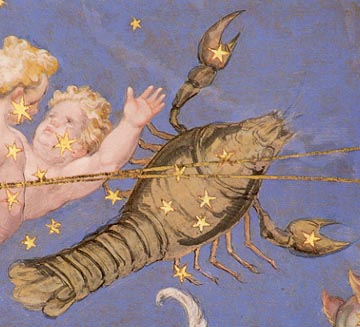
BOOTES
Latin : Bootes
Greek : Boôtes (the Wagon-Driver) or Arktophylax (the Bear-Watcher)
Akkadian : Niru (the Yoke)
Sumerian : SHUDUN (the Yoke)
ARCAS An early king of Arkadia. When he was about to kill his mother Callisto who had been transformed into a bear, Zeus raised the pair to heavens as the constellations Arctophylax (the Bear-Watcher) andUrsa (the Bear). (Hyginus 2.4.)
BOOTES The inventor of the wagon or plough, a son of the goddess Demeter. As a reward for this service to mankind he was placed amongst the stars as the constellation Bootes. His oxen and plough were set alongside him as the Wain, i.e., the constellations Ursa Major and Minor. (Hyginus 2.4 on Hermippus & Petellides.)
ICARIUS An Athenian devotee of Dionysus. He was instructed by the god in the art of winemaking, but was murdered by peasants who mistook the draught for poison. Dionysus then placed him, his daughter Erigone and their dog Maira, amongst the stars as the constellations Bootes, Virgo and Canis Major. (Hyginus 2.4 on Eratosthenes.)
CANCER
Latin : Cancer (the Crab)
Greek : Karkinos (the Crab)
Akkadian : Alluttu (the Crab)
Sumerian : AL.LUL (the Crab)
Latin : Aselli (the Asses)
Greek : Oinoi (the Asses)
CARCINUS A crab of the Lernaean swamp which assisted the Hydra in her battle with Heracles. The hero crushed it beneath his heel, and also despatched the serpent, but as a reward for their service Hera placed the pair amongst the stars in the form of the constellations Cancer and Hydra. (Hyginus 2.23.)
ASSES OF DIONYSUS 1 The Asses were two stars set on the back of the constellation Cancer. They were a pair of donkeys who helped Dionysus cross a swamp when he was on his way to Dodona in search of a curse for the madness inflicted upon him by Hera. Upon recovering, the god awarded the pair with a place in the heavens as stars. (Hyginus 2.23.)
ASSES OF DIONYSUS 2 The two asses of Cancer were also said to have been placed there as a reward for their service in the Giant War. For when Dionysus and Silenus rode into battle upon their backs, the strange sound of their braying put the Giants into a rout. (Hyginus 2.23.)
ASS OF SILENUS The donkey mount of the old rustic god Silenus. The beast once entered into a contest with Priapus over the size of their erect members. The god won and killed the beast, but Dionysus in pity set it amongst the stars on the back of Cancer. (Hyginus 2.23.)
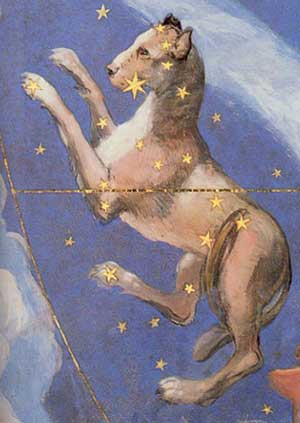
CANIS MAJOR
Latin : Canis (the Dog)
Greek : Kyôn (the Dog)
Latin : Sirios
Greek : Seirios or Kyon Aster (the Dog-Star)
LAELAPS A magical dog which was destined never to surrender a chase. It was first bestowed on Europa by Zeus, who passed it to her son Minos, and from him to Procris and Cephalus. The last of these set it to hunt down the Teumessian fox, which was destined never to be caught. To resolve the contrary fates of the two animals, Zeus placed them amongst the stars as the constellations Canis Major and Minor to play out the chase unresolved for eternity. (Hyginus 2.35.)
DOG OF ORION The dog of the giant hunter Orion who stands above it in the heavens. He leads it in the chase of the hare (Lepus) or the fox (Canis Minor). (Hyginus 2.35.)
MAERA The dog of Icarius, a devotee of the god Dionysus. When his master was murdered, and his mistress committed suicide, the dog threw himself down a well. All three were then placed amongst the stars as Procyon (Canis Minor), Bootes and Virgo. (Hyginus 2.4 & 2.35.)
SIRIUS The dog-star which crowns the head of the constellation Canis Major. Its rising in conjunction with the sun at dawn was thought to bring on the scorching heat of mid-summer. The Egyptians called it the star of Isis. (Hyginus 2.35.)CANIS MINOR
Latin : Canicula (the Little Dog)
Greek : Prokyôn (the Fore Dog)
Akkadian : Shelebu (the Fox)
Sumerian : KA.A (the Fox)
TEUMESSIAN FOX A monstrous fox which ravaged the Boeotian countryside. The hero Cephalus set the magical dog Laelaps to hunt it down. But because the pair had conflicting fates - one was destined never to be caught, and the other never to surrender the chase--Zeus transferred the pair to the heavens to play out their contest unresolved for all eternity. (Hyginus 2.35.)
OTHER DOGS The dogs of Icarius and Orion were sometimes identified with Canis Minor instead of the usual Canis Major. (Hyginus 2.36.)
CAPRICORN
Latin : Capricorn (the Goat Horn)
Greek : Aigokerôs
(the Goat Horn)
Akkadian : Suhurmashû (the Goat-Fish)
Sumerian : SUHUR.MÁSH (the Goat-Fish)
AEGIPAN 1 A goatish sea god who came to the assistance of Zeus in the War of the Titans, and filled the enemy with panic. As thanks for his help the god set him amongst the stars as the goat-fish constellation Capricorn. (Hyginus 2.28 on Eratosthenes.)
AEGIPAN 2 When the monster Typhon attacked Olympus, the gods fled in a body to Egypt and hid themselves away in the form of animals. The god Pan transformed himself into a goat-fish and hid dived into a river. Later after Zeus had been disabled by the giant, Aegipan recovered his stolen sinews and so restored him. For this service he was awarded with a place amongst the stars as the constellation Capricorn. (Hyginus 2.28.)
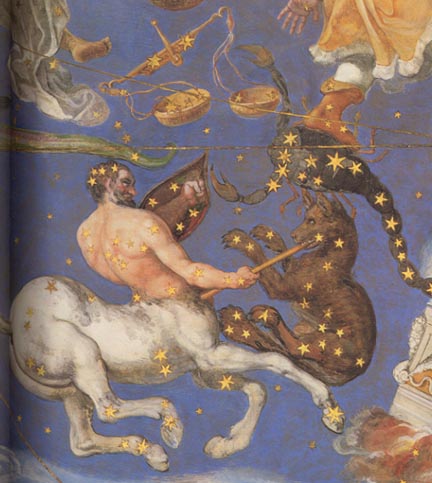
CASSIOPEIA
Latin : Cassiopeia
Greek : Kassiepeia
CASSIOPEIA A queen of Ethiopia, mother of the lovely Andromeda. When she boasted that her daughter was more beautiful than the Nereids, Poseidon sent a sea monster to devour the girl. She was rescued by Perseus, who slew the beast. As a memorial the whole family were placed amongst the stars, but Cassiopea because of her pride, was set to hang eternally upside down on her throne. (Hyginus 2.10 on Euripides & Sophocles.)
CENTAURUS
Latin : Centaurus (the Centaur)
Greek : Kentauros (the Centaur)
Akkadian : Habasiranu
Sumerian : EN.TE.NA.BAR.HUM
CHIRON The wisest of the Centaurs, a son of the Titan Cronus. He once entertained Heracles, but when examining his poisonous arrows dropped one on his foot. Because of the unbearable pain of the wound, he surrendered his immortality and was placed amongst the stars as the constellation Centaurus. Others say he became Saggitarius. (Hyginus 2.38.)
PHOLUS A centaur of Mount Pholoe in Arcadia who entertained Heracles in his cave. But when he opened the wine, the smell drew the other centaurs who attacked. Heracles slew them, but Pholus examining one of the poisonous arrows let it fall on his foot and died. The gods placed him amongst the stars as the constellation Centaurus, along with his drinking cup Crater. Some say Centaurus is depicted pouring a libation at the altar, Ara. (Hyginus 2.38.)
CEPHEUS
Latin : Cepheus
Greek : Kêpheus
CEPHEUS A King of Aethiopia and father of the lovely Andromeda. He was forced to sacrifice his daughter to a sea monster because the boasts of his wife Cassiopea offended the gods. But the hero Perseus slew the beast and rescued her. As a memorial the whole family--Cepheus, Cassiopea, Andromeda and Perseus--were placed amongst the stars. (Hyginus 2.9.)
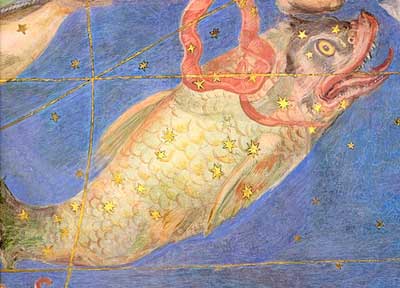
CETUS
Latin : Cetus (the Sea Monster or Whale)
Greek : Kêtos (the Sea Monster or Whale)
ETHIOPIAN CETUS A sea monster which was sent by Poseidon to ravage the land of Ethiopia to punish Queen Cassiopea for her prideful boasts comparing her daughter Andromeda to the Nereids. The girl was offered up as sacrifice to the monster, but was rescued by the hero Perseus. To commemorate the event, the monster was placed amongst the stars as the constellation Cetus, along with Perseus and Andromeda. (Hyginus 2.31.)
CORONA
Latin : Corona (the Crown)
Greek : Stephanos (the Crown)
Akkadian : A-nim (the Crown of Anu)
Sumerian : AGA (the Crown of Anu)
CROWN OF ARIADNE The crown of the Cretan princess Ariadne. She received from the gods as a wedding gift upon her marriage to the god Dionysus. After her death it was set amongst the stars as the constellation Corona. (Hyginus 2.5.)
CROWN OF DIONYSUS The crown of the god of wine. He received it as a gift from Aphrodite and after his return from the underworld with his mother Semele he set it amongst the stars in memorial of the event. (Hyginus 2.5 on the Argolica.)
CROWN OF THESEUS The crown of the Athenian hero Theseus which he received from the goddess Amphitrite as a mark of his divine paternity. He in turn gave it to Ariadne as reward for the assistance she provided him in navigating the passages of the Labyrinth. At her death it was placed amongst the stars. (Hyginus 2.5.)
CORVUS
Latin : Corvus (the Crow)
Greek : Koronis (the Crow) or Korakos (the Raven)
Akkadian : Aribu (the Raven)
Sumerian : UGA-MUSHEN (the Raven)
CORONIS A Thessalian girl loved by the god Apollo. But she proved unfaithful and Artemis slew her with her arrows. The god then placed Coronis (literally, "the Crow") amongst the stars as the constellation Corvus. Her son by Apollo was Asclepius, the constellation Ophiochus. (Hyginus 2.40 on Istrus.)
CROW OF APOLLO A crow which was sent by Apollo to fetch water for libations. It tarried in the task, and as punishment was placed amongst the stars as the constellation Corvus, along with the serpent Hydra, and the water-cup Crater. The serpent prevented the crow from drinking at the bowl leaving it eternally parched in the heavens. (Hyginus 2.40.)
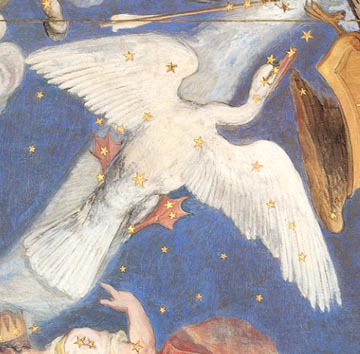
CRATER
Latin : Crater (the Drinking Cup)
Greek : Krêtêr (the Drinking Cup)
CUP OF PHOLUS The drinking cup of the the centaur Pholos. It and its owner were placed amongst the stars as the adjacent constellations Crater and Centaurus. (Hyginus 2.38.)
CUP OF APOLLO A cup placed amongst the stars by Apollo in form of the constellation Crater, next to Corvus the crow and Hydra the serpent. The serpent was set to guard the bowl, preventing the crow from drinking. (Hyginus 2.40.)
CYGNUS
Latin : Cygnus (the Swan)
Greek : Ornis (the Bird) or Kygnos (the Swan)
SWAN OF LEDA When Zeus wanted to seduce the goddess Nemesis he transformed himself into a swan, and bade Aphrodite in the guise of an eagle pursue him into her lap. As a memorial of this successful ruse he placed an eagle and swan in the sky as the constellations Cygnus and Aquila. (Hyginus 2.8.)
DELPHINUS
Latin : Delphinus (the Dolphin)
Greek : Delphin (the Dolphin)
Sumerian : SHAH (the Pig or Boar)
DOLPHIN OF POSEIDON When Poseidon was wooing the goddess Amphitrite, she fled from his advances and hid herself away. Dolphin (Delphin) was sent to find her, and he persuaded her to return. As a reward for this service Poseidon set him amongst the stars as a constellation. (Hyginus 2.17 on Eratosthenes.)
DOLPHINS OF DIONYSUS When Dionysus was travelling between the islands of the Aegean, he was captured by Tyrrhenian pirates. The god drove them to terror with his illusions and, when they leapt from the ship, he transformed them into dolphins. In memory of the event he placed a dolphin amongst the stars. (Hyginus 2.17 on Aglaosthenes.)
DOLPHIN OF ARION When the famed Corinthian bard Arion was thrown overboard by seamen who coveted his wealth, a dolphin came and carried him safely to shore. As memorial the kindly animal was placed amongst the stars. (Hyginus 2.17.)
DRACO
Latin : Draco (the Dragon)
Greek : Drakôn (the Dragon)
HESPERIAN DRAGON The huge serpent which guarded the golden apples of the Hesperides. After the beast was slain by Heracles, Hera placed it amongst the stars as Draco. (Hyginus 2.3 on Eratosthenes.)
DRAGON OF ATHENA A gigantic serpent which was cast at the goddess Athena during the giant war. She caught it in her hands and set it about the northern pole as the constellation Draco. (Hyginus 2.3.)
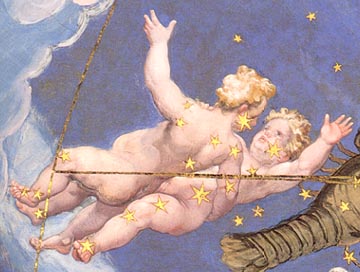
ERIDANUS
Latin : Eridanus
Greek : Êridanos or Potamos (the River)
Akkadian : Purattu (the Euphrates)
Sumerian : BURANUN (the Euphrates)
ERIDANUS A river believed to flow through the mythical northern land of Hyperborea. It was set to flow amongst the northern stars. (Hyginus 2.32.)
NILE The great river of Egypt was placed amongst the stars as the constellations Eridanus and Delta. The brightest star in its heavenly stream was named Canopus. (Hyginus 2.32.)
GEMINI
Latin : Gemini (the Twins)
Greek : Didymoi (the Twins)
Akkadian : Tu'amu rabûtu (the Great Twins)
Sumerian : MASH.TAB.BA.GAL.GAL (the Great Twins) & MASH.TAB.BA.TUR.TUR (the
Little Twins), the 4 main stars of Gemini
DIOSCURI Twin sons of Zeus, named Castor and Polydeuces. The pair were famed horsemen who were transferred to the heavens at death to form the constellation Gemini. The Dioscuri came to the rescue of sailors in distress. (Hyginus 2.22.)
HERACLES & APOLLO When Apollo commanded that Heracles be sold into slavery to atone for murder, the hero was enraged as wrestled the god for the Delphic tripod. Their match was memorialised amongst the stars as the constellation Gemini. (Hyginus 2.22.)
TRIPTOLEMUS & IASION The two favourites of the goddess Demeter. Triptolemus was a hero who first instructed mankind in the art of agriculture, while Iasion was her lover on the island of Samothrace, lying with her in a thrice-plowed field. (Hyginus 2.22.)
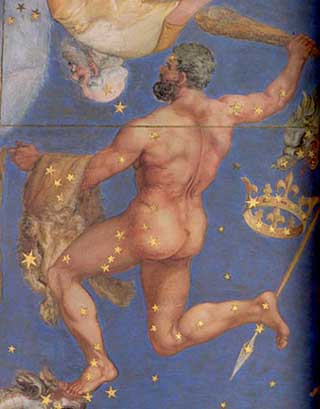
HERCULES
Latin : Hercules
Greek : Engonasin (the Kneeler)
Sumerian : (the Stag?)
HERACLES THE DRAGON-SLAYER The great hero was placed amongst the stars in the form of a kneeling man with his club poised to strike the Hesperian dragon, the constellation Draco. (Hyginus 2.6 on Panyassis & Eratosthenes.)
HERACLES IN LIGURIA The great hero was said to have been placed amongst the stars in the shape of kneeling man, as a memorial of his desperate battle with the Ligurians, whom he encountered on his return trip to Greece with the cattle of Geryon. (Hyginus 2.6 on Euripides.)
IXION An Lapith king who attempted to rape the goddess Hera. As punishment for his crime he was bound to a fiery wheel and fixed in the heavens as the constellation Engonasin, a warning to others. (Hyginus 2.6.)
PROMETHEUS As punishment for his defiance of Zeus, the Titan Prometheus was chained to Mount Caucasus where an eagle set to feed on his ever-regenerating liver. Heracles later released him from his torment, felling the eagle with an arrow. In memory of this deed, Prometheus, the arrow and the eagle were placed side by side amongst the stars as the constellations Engonasin, Aquila (or Lyra the vulture) and Sagitta. (Hyginus 2.6.)
ORPHEUS A Thracian bard who was torn to pieces by the Bacchantes when they caught him spying on their secret rites. He was placed amongst the stars by Apollo and the Muses as a kneeling man with a lyre. The lyre was represented by the adjacent constellation Lyra. (Hyginus 2.6.)
THAMYRIS A bard who was blinded by the Muses as punishment for daring to challenge them to a musical contest. He was placed amongst the stars as a man bent down on one knee in supplication along with his lyre. (Hyginus 2.6.)
THESEUS The Athenian hero was set amongst the stars in the pose of a kneeling man, the constellation Ennosagin. In this way he was depicted lifting the stone at Troezen under which Aegeus had laid the sword as proof of his paternity. Some say, the adjacent constellation Lyra was his. (Hyginus 2.6 on Hergesianax.)
CETEUS A King of Arcadia who was placed amongst the stars as the constellation Kneeler. He was depicted kneeling in lamentation with a hand reached out to his daughter Megisto, the constellation Ursa Major, who had been transformed into a bear. (Hyginus 2.1 & 2.6 on Araethus of Tegea.)
HYDRA
Latin : Hydra (the Water Serpent)
Greek : Hydra (the Water Serpent)
Summerian : MUSH (the Snake)
LERNAEAN HYDRA A monstrous nine-headed serpent which haunted the springs of Lerna. Heracles slew it as one of his twelve labours, along with its ally the crab. Hera placed the pair in the heavens as the constellations Hydra and Cancer. (Hyginus 2.40.)
SERPENT OF APOLLO A water-serpent was placed amongst the stars by the god Apollo in the form of the constellation Hydra, to guard the heavenly bowl Crater, preventing the crow Corvus from drinking. (Hyginus 2.40.)
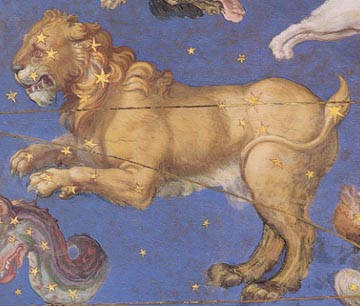
LEO
Latin : Leo (the Lion)
Greek : Leon (the Lion)
Sumerian : UR.GU.LA (the Lion)
NEMEAN LION A lion whose hide was impervious to weapons which terrorized the countryside of Nemea. When Heracles was commanded to destroy it was one of his twelve labours, he throttled the beast to death with his bare hands. The lion was then placed by Hera amongst the stars as the constellation Leo. (Hyginus 2.24.)
KING LION The lion, king of all the beasts, was set amongst the stars as the constellation Leo in recognition of his supremacy. (Hyginus 2.24.)
LEPUS
Latin : Lepus (the Hare)
Greek : Largos (the Hare)
HARE OF ORION A hare which was set amongst the stars before the hunter Orion and his dog (Canis) to play out an eternal chase. (Hyginus 2.33.)
HARE OF HERMES A hare was placed amongst the stars by the god Hermes in honour of the species' bountiful fertility. (Hyginus 2.33.)
HARE OF LEROS The island of Leros was once free of hares, until a young man brought a pregnant female into the country as a pet. The fast-breeding animals quickly got out of control and devoured everything on the island, forcing the inhabitants to abandon their homes. As a warning to others, a hare was placed amongst the stars by the gods. (Hyginus 2.33.)
LIBRA
Latin : Libra (the Scales)
Greek : Zyygos (the Scales) or Khêlai (the Claws)
Akkadian : Zibanitu
(the Scales)
Sumerian : ZI.BA.AN.NA (the Scales)
SCALES OF JUSTICE The scales of Astraea, the goddess of justice, were placed beside her in the heavens as the constellation Libra. Astraea herself was Virgo. (Hyginus 2.25.)
SCALES OF FATE The scales of Tyche, goddess of fortune, were set amongst the stars as the constellation Libra. Tyche herself was one of the goddesses identified as Virgo. (Hyginus 2.25.)
CLAWS OF THE SCORPION The claws of the constellation Scorpio were sometimes said to be represented amongst the stars as Libra. (Hyginus 2.26.)
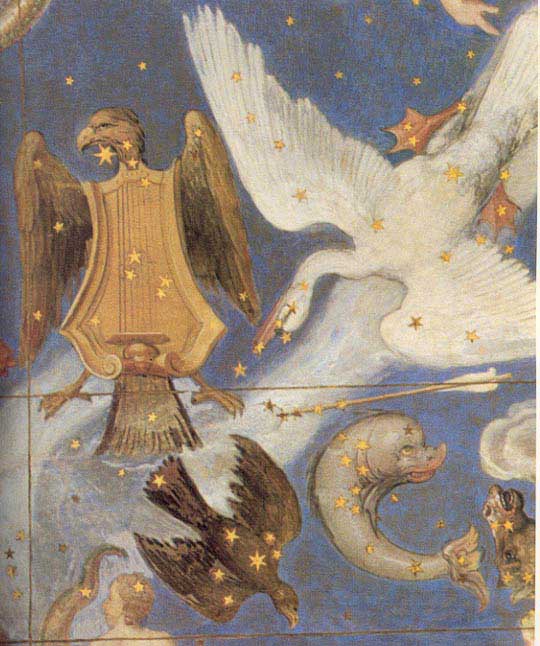
LYRA
Latin : Lyra (the Lyre)
Greek : Lyrê (the Lyre) or Khelys (the Tortoise)
Akkadian : Enzu (the She-Goat)
Sumerian : ÙZ (the She-Goat)
LYRE OF HERMES The lyre first carved by the god Hermes out of the shell of a tortoise. He traded it with Apollo for the caduceus, who set it amongst the stars as memorial. (Hyginus 2.7, Aratus 268.)
LYRE OF ORPHEUS The lyre of the great bard Orpheus, who could charm animals, trees and rocks with his music. After he was slain by the Bacchantes, Apollo and the Muses placed his lyre amongst the stars. Some say Orpheus was himself represented nearby in the form of the constellation "Hercules," the Kneeling Man. (Hyginus 2.7 on Eratosthenes.)
LYRE OF THESEUS The lyre of the hero Theseus who was set in the stars as the constellation "Heracles" next to that of the lyre. (Hyginus 2.6.)
LYRE OF THAMYRIS A bard who was blinded by the Muses. He was placed amongst the stars as a warning along with his lyre as the constellations Ennosagin (or "Hercules") and Lyra. (Hyginus 2.6.)
OPHIUCHUS
Latin : Ophiuchus
Greek : Ophiokhos (the Serpent Holder)
ASCLEPIUS The great physician, a son of the god Apollo. When Asclepius dared to extend his craft by bringing back men from the dead, Zeus struck him dead with a thunderbolt. As a memorial the hero was placed amongst the stars along with the serpent which coiled around his staff. (Hyginus 2.14.)
CARNOBON A King of the Getae tribe of Thrace. When the hero Triptolemus passed through his land instructing mankind in agriculture, he set an ambush and slew one of his flying serpents. The goddess punished Carnobon and afterwards set him amongst the stars struggling eternally with a serpent as warning. (Hyginus 2.14.)
HERACLES THE DRAGON-SLAYER The great hero. Heracles spent time in the service of Queen Omphale of Lydia, where he slew a gigantic serpent which was ravaging the land. As a memorial Zeus commemorated the deed amongst the stars of heaven. (Hyginus 2.14.)
PHORBAS A hero of the island of Rhodes. When the island was plagued by serpents, Phorbas destroyed them all, and as a reward for this service was placed amongst the stars by the god Apollon. (Hyginus 2.14 on Polyzelus the Rhodian.)
TRIOPAS A Thessalian king. In his greed he tore the roof from a temple of Demeter for his own palace. The goddess in wrath inflicted him with unquenchable hunger and sent a serpent to further plague him. When he died she set him amongst the stars to continue for eternity the struggle with the serpent. (Hyginus 2.14.)
ORION
Latin : Orion
Greek : Ôriôn (the Mountain Man?)
Akkadian : Shidallu (the True Shepherd of Anu)
Sumerian : SIPA.ZI.AN.NA (the True Shepherd of Anu)
ORION A giant hunter who was set amongst the stars as the constellation Orion. Some say he chased Lepus, the hare, across the heavens with his dog, the constellation Canis, others that he was in pursuit of Taurus the bull, or even chasing after the seven beautiful Pleiad nymphs. In the story of his death, Orion was either killed by Artemis or by a scorpion sent by Gaea to punish him for boasting that he would slay all the creatures of the earth. The scorpion was also placed amongst the stars and continued to plague him, for as it rose in the east, Orion fled beneath the horizon in the west. (Hyginus 2.34 on Hesiod & Aristomarchus & Istrus, Aratus 634.)
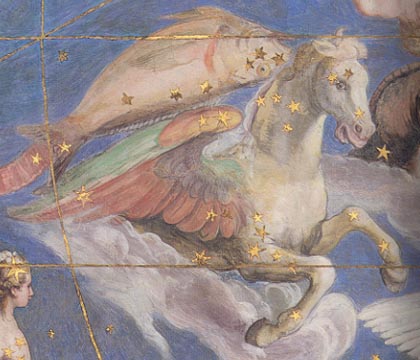
PEGASUS
Latin : Equus (the Horse)
Greek : Hippos (the Horse) or Pegasos
Akkadian : Sisû (the Horse)
Sumerian : ANSHE.KUR.RA (the Horse)
PEGASUS A winged horse, son of the Gorgon Medusa. It was tamed by the hero Bellerophon who rode it into battle against the three-headed monster Chimera. When he later tried to fly to heaven, he was thrown back down to earth, but the horse was received and set amongst the stars by Zeus. (Hyginus 2.18 on Aratus, Aratus 205.)
MELANIPPE A daughter of the centaur Chiron. When she became pregnant by the hero Aeolus, she hid herself away in a forest in shame, and prayed that her father might not find her. The gods then transformed her into a horse, and after her child was born set her amongst the stars as a constellation. There she was said to continue to hide from her father, setting just as her father's own constellation was on the rise. (Hyginus 2.18 on Euripides.)
PERSEUS
Greek : Perseus (the Destroyer)
Akkadian : Shibu (the Old Man)
Summerian : SHU.GI (the Old Man)
PERSEUS An Argive hero, the son of Zeus and Danae. When he was returning on his quest for the Gorgon's head, he spied the Ethiopian princess Andromeda chained to the rocks as sacrifice to a sea-monster. Perseus slew the beast and saved the girl. In memorial of the event Athena placed Perseus, Andromeda, Cepheus and Cassiopea (the girl's parents) and Cetus (the Sea Monster) amongst the stars. (Hyginus 2.12, Aratus 248.)
PISCES
Latin : Pisces (the Fishes)
Greek : Ikhthyes (the Fishes)
Akkadian : Nunu (the Fish) & Shinunutu (the Swallow)
Sumerian : KU (the Fish) & SIM.MAH (the Swallow)
FISHES OF APHRODITE When the monster Typhon attacked Olympus, the gods fled in a body to the south. Aphrodite and her son Eros reached the river Eridanus where they threw themselves in the water and hid in the guise of fish. In memory of the event a pair of fish were set amongst the stars as the constellation Pisces. (Hyginus 2.30 on Diognetus Erythraeus.)
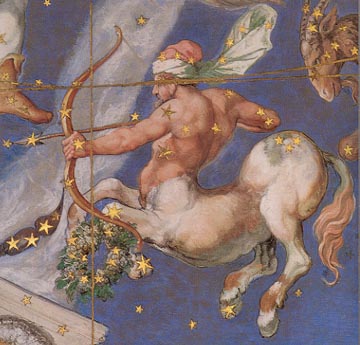
SAGGITA
Latin : Saggita (the Arrow)
Greek : Oistos (the Arrow)
Sumerian : KAK.SI.KI (the Arrow)
ARROW OF APOLLO The arrow which Apollo used to slay the Cyclopes, to avenge the death of his son Asclepius who had been destroyed by a thunderbolt created on their forge. Both Asclepius and the arrow were placed amongst the stars, as Ophiochus and Sagitta respectively. (Hyginus 2.15 on Eratosthenes.)
ARROW OF HERACLES The arrow with which Heracles slew the eagle set to torment the Titan Prometheus. The eagle and arrow were placed side by side in the heavens as the constellations Aquila and Sagitta. (Hyginus 2.15.)
SAGITTARIUS
Latin : Sagittarius (the Archer)
Greek : Toxeutês (the Archer)
Sumerian : PA.BIL.SAG
CHIRON The wise centaur Chiron was placed amongst the stars as the constellation Saggitarius or Centaurus, when he surrendered his immortality after being poisoned by an arrow of Heracles.
CROTUS A horse-legged, satyr hunter who was a companion of the Muses on Mount Helicon. As a reward for his zeal he was placed amongst the stars as the constellation Saggitarius. His victory wreath was further set as a circle of stars at his feet. (Hyginus 2.27 on Sositheus.)
SCORPIO
Latin : Scorpio (the Scorpion)
Greek : Skorpios (the Scorpion)
Akkadian : Zuqaqipu (the Scorpion)
Sumerian : GÍR.TAB (the Scorpion)
SCORPION OF ORION A scorpion sent forth by the earth-goddess Gaea to kill Orion when the giant boasted that he would slay all the animals of the earth. The pair were placed amongst the stars as the constellations Scorpio and Orion. The ancients sometimes combined a pair of constellations to create the the scorpion, with Libra forming the claws. (Hyginus 2.26, Aratus 634.)
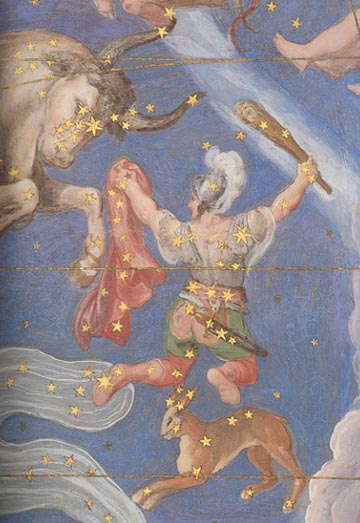
TAURUS
Latin : Taurus (the Bull)
Greek : Tauros (the Bull)
Sumerian : GU.AN.NA (the Bull of Heaven)
Latin : Suculae (the Suckling Pigs)
Greek : Hyades (the Rainy Ones)
Latin : Vergiliae
Greek : Pleiades (the Ladies of Plenty)
Akkadian : Zappu (the Bristle)
Sumerian : MUL.MUL (the Stars)
BULL OF EUROPA When the Phoenician princess Europa was playing by the sea shore, Zeus approached her in the guise of a bull and, tempting her to climb onto his back, carried her away to the island of Crete. (Hyginus 2.21 on Euripides.)
IO THE HEIFER The Argive princess Io was loved by Zeus, who transformed her into a cow to hide her from the jealous gaze of his wife Hera. She was nevertheless recognised by the goddess who set a maddening gladfly to torment her that drive her wandering to Egypt. There Io was restored to human form and gave birth to her son Epaphos. As a memorial of her trials, Io was set amongst the stars as the constellation "Taurus." (Hyginus 2.21.)
HYADES Five nymphs whose stars outline the face of the bull Taurus. They were nurses of the god Dionysus who were awarded for their service with a place amongst the stars of heaven. Their rising heralded the onset of the rainy season in Greece. Some say they were teary nymphs placed in the heavens following the death of their brother Hyas, who was killed by a lion. Presumably this Hyas and the lion were represented by the constellations Aquarius and Leo. (Hyginus 2.21 on Pherecydes.)
PLEIADES Seven nymphs whose stars form the "tail of the Bull" Taurus. The sisters were placed amongst the stars by the god Zeus, after the lustful giant Orion had pursued them across the earth for seven years. Orion was also set in heaven, but doomed to continue a futile chase for all eternity. (Hyginus 2.21, Aratus 254.)
TRIANGULUM
Latin : Triangulum (the Triangle)
Greek : Deltôton (the Triangle or letter D)
DIVISION OF THE COSMOS A triangle was placed amongst the stars to commemorate the division of the universe amongst the three sons of Cronus : Zeus received the heavens, Poseidon the sea, and Hades the underworld. (Hyginus 2.19.)
D FOR DIOS The Greek letter Delta (shaped like a triangle) was placed amongst the stars by Hermes to mark more clearly the faint sign of Aries. It was also placed as a memorial of his invention of the alphabet, the letter D being chosen to signify the name of Zeus (spelt Dios, Dii, in other forms). (Hyginus 2.19.)
DELTA OF EGYPT The triangle formed by the delta of the River Nile was placed amongst the stars as the constellation of the same name. Others say the triangle represented the whole of Egypt from the Nile border with Egypt down to the sea. (Hyginus 2.19.)
ISLAND OF SICILY The triangle shaped island of Sicily was represented amongst the stars as the constellation Triangulum. The reason for its placement is not known. (Hyginus 2.19.)
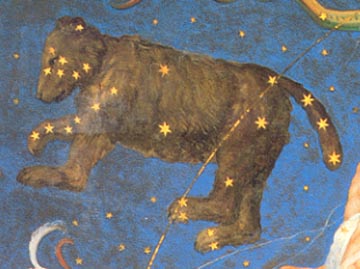
URSA MAJOR
Latin : Ursa Major (the Great Bear)
Greek : Arktos Megale (the Great Bear) or Amaza (the Wagon) or Helikê
Akkadian : Eriqqu (the Wagon)
Sumerian : MAR.GÍD.DA (the Wagon)
CALLISTO An Arcadian princess who was loved by the god Zeus and transformed into a bear by the wrathful goddess Artemis or Hera. She was later placed amongst the stars as the constellation Ursa Major, along with her son Arcas, who became Bootes. Hera was still furious and forbade Callisto's stars ever set into the river Oceanus. (Hyginus 2.1 & 2.4 from Hesiod & Amphis & others.)
HELICE A nymph who nursed the infant god Zeus on Mount Ida in Crete. As a reward for her service, she was placed amongst the stars as the constellation Ursa Major, along with her sister Cynosura as Ursa Minor. (Hyginus 2.2 on Aglaosthenes, Aratus 25.)
MEGISTO An Arcadian princess, daughter of King Ceteus. She was transformed into a bear and placed amongst the stars as the constellation Ursa Major. Her father and was placed beside her in the form of the Kneeler ("Hercules") apparently lamenting her fate. (Hyginus 2.1 & 2.6 on Araethus of Tegea.)
WAIN OF BOOTES The ox-drawn wagon or plough of the farmer Bootes was set amongst the stars in the form of the constellation Ursa Major. Their driver stands immediately behind it in the heavens. (Hyginus 2.2.)
URSA MINOR
Latin : Ursa Minor (the Little Bear)
Greek : Arktos Mikra (the Little Bear) or Amaza (the Wagon) or Kynosoura (the Dog's
Tail)
CYNOSURA An Idaean nymph who nursed the infant god Zeus in the Dictaeon cave of Crete. She and her sister Helice were placed amongst the stars as the constellation Ursa Minor and Major, as a reward for their service. (Hyginus 2.2 on Aglaosthenes, Aratus 25.)
PHOENICE A Phoenician girl or bear who was set amongst the stars as the constellation Ursa Minor. The ancient Phoenicians navigated by her stars. (Hyginus 2.2 on Thales of Miletus.)
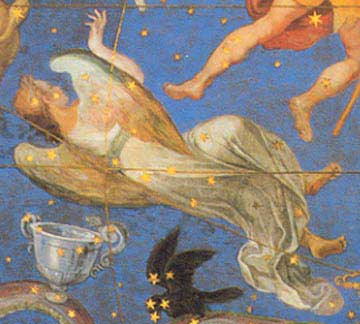
VIRGO
Latin : Virgo (the Virgin)
Greek : Parthenos (the Virgin)
Latin : Vindemiator (the Vintager)
Greek : Protrugêtêr (the Vintager)
ASTRAEA The maiden goddess of justice, who departed from the earth at the start of the Brazen Age of Man. She was given a place amongst the stars as the winged constellation Virgo, with her scales set nearby in the form of Libra. (Hyginus 2.25 on Hesiod & Aratus, Aratus 96.)
TYCHE The goddess of good fortune was set amongst the stars as Virgo, along with the scales of fate, Libra. (Hyginus 2.25.)
DEMETER The goddess of agriculture was given a memorial amongst the stars in the form of the constellation Virgo, which some say holds a sheaf of wheat in its hand. (Hyginus 2.25.)
ERIGONE An Athenian maiden, the daughter of Icarius, the man who Dionysus first instructed in the making of wine. When her father was killed by peasants who mistook thought the wine was poison, she committed suicide by hanging herself from a tree. Dionysus afterwards placed the pair amongst the stars as the constellations Virgo and Bootes. Their dog Maera was set nearby as Canis Major. (Hyginus 2.4 & 2.25.)
PARTHENOS A maiden daughter of Apollon who died young and was set amongst the stars by her father as the constellation Virgo. (Hyginus 2.25.)
THE VINTAGER A star on the right wing of the constellation Virgo. (Aratus 137.)
THE MILKY WAY
Latin : (Milky Way)
Greek : Gala (Milky Way)
MILK OF HERA Zeus once conspired to place the infant Heracles at the breast of Hera. The goddess woke from her sleep, because of the roughness of the child, and pushed him away in disgust. The milk which flowed forth formed the Milky Way. (Hyginus 2.43.)
MILK OF RHEA When the Titaness Rhea presented a stone wrapped in swaddling cloth to Cronus as substitute for the infant Zeus, the Titan pressed it against her breast and milk flowed forth which flowed formed the Milky Way. (Hyginus 2.43.)
